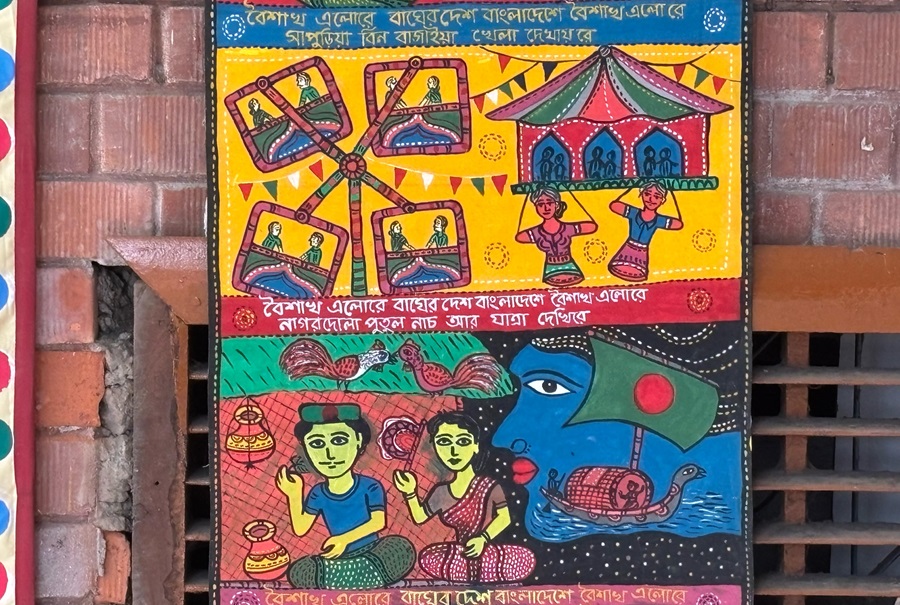
Published :
Updated :

Pohela Boishakh is more than a calendar date because it emerges as a cultural masterpiece that expresses memories and fresh aspirations through musical notes, food flavours, and widespread shades. During our Pohela Boishakh celebrations, red and white dominate the most prominent festival colour partnership.
The Bengali New Year fashion seems to be under the absolute control of red and white, which makes enthusiasts wonder why these pairings dominate the style trends. Let's unravel this sartorial saga.
Red meets white
Red and white colours would create a romantic union if they could love each other. The minimalist white design presents itself as an empty sheet that invites new stories about fresh beginnings and rebirth. And red? Oh, red is the heartbeat. It's love, luck, and laughter.
These colours create an alliance that exceeds design standards and becomes an artistic representation of words and meanings.
A crimson border, along with the cotton-white sari (also known as laal paar) and wearing a red-threaded kurta with a white base, represents a traditional fashion statement.
These two colours have maintained an ancient relationship between happiness and tranquillity and cultural heritage and passion over time.
Boishakh began during the Mughal period
The beginning of Pohela Boishakh did not originate from musical celebrations, mangoes, or sweet desserts. It started with money. The Mughal Emperor Akbar introduced his slightly bureaucratic yet brilliant idea during the 16th century.
Farmers received a solution to their financial woes through the introduction of Bonggabdo by the Bengali calendar system.
The solar calendar made its agricultural connections by using precise synchronisation of dates.
The monetary festival establishing taxes and fairs took place on the year's inaugural date for financial renewal. Authorities developed the original economic strategy into a day that united people through widespread celebration alongside cultural recognition.
Seasons in style: Nature's palette behind the red & white
After numerous years, that tax day expanded into a tremendous celebration known as a carnival. The red-and-white dress code carries beyond fashion because nature served as its poetic inspiration.
Bengal becomes a picturesque garden under the vibrant celebration of Pohela Boishakh in April.
The cool early summer climate featuring crisp cotton clouds matches white. At the same time, the glowing sun with ripening fields and fire-filled hopes of fresh starts embodies red in the dress code.
The laal-paar sari and the red-accented panjabi are more than fashionable dress combinations because they represent seasonal elements, soil, and fresh beginnings.
A palette of unity and tradition
When you walk Boishakhi streets, all you need to do is see the colours of solidarity painted by the human crowd. A festival parade emerges into a living art form, where people wear sarees like blooming flowers and kurtas like flowing water rivers while wearing flower crowns like floating elements across the celebration.
The fashion aspect gives everyone a reason to sparkle, but eyes only represent the framework of this event. The light and breathable April-heat-suitable cotton material enhances the timeless traditional colour combination.
Timeless. Inside these clothes runs a special power that unites individuals. People from all religions and languages with different backgrounds share the bond of red and white colour to establish commonality.
Tradition gets a tailor-made upgrade
Tradition never stands still; it adjusts to current trends and evolves naturally. With your creativity and DIY fashion ideas, enter the modern Boishakhi lookbook.
Contemporary fashion designers transform traditional elements by creating red and white jumpsuits with monochromatic sarees accented with embroidered crimson details, hand-painted designs, and Indo-Western clothing combinations that attract attention despite their cultural heritage roots.
Fashion-oriented people reimagine traditional customs through novel creative perspectives, including handcrafted items with gender-neutral drapes. The natural growth of style follows the same principle as cultural evolution by allowing free movement.
The Pohela Boishakh celebration extends beyond yearly counting to become an essential life pulse that unites people across all times throughout the cosmos.
Our yearly choice of wearing red with white clothing represents much more than personal attire. These articles of clothing reveal more than their wearable nature because they function as tellers of stories.
These costumes represent celebrations with solemnity, personal style, and communal celebrations.
Every item of clothing with a laal paar and a kurta with a red border symbolises culture through colour. It's joy stitched into tradition because it's our Pohela Boishakh.
Shubho Noboborsho!
Samiha Mamun is an undergraduate student at the Army Institute of Business Administration (Army IBA), affiliated with the Bangladesh University of Professionals in Savar, Dhaka. She can be reached at samihamamunmeem@gmail.com


 For all latest news, follow The Financial Express Google News channel.
For all latest news, follow The Financial Express Google News channel.